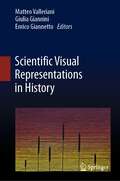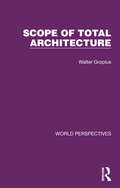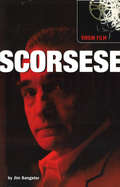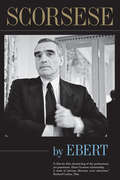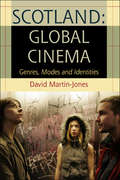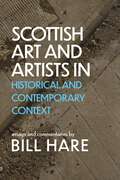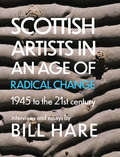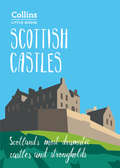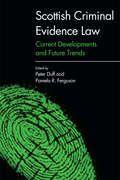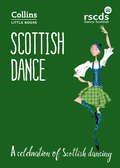- Table View
- List View
Scientific Visual Representations in History
by Matteo Valleriani Enrico Giannetto Giulia GianniniThis book explores continuity and ruptures in the historical use of visual representations in science and related disciplines such as art history and anthropology. The book also considers more recent developments that attest to the unprecedented importance of scientific visualizations, such as video recordings, animations, simulations, graphs, and enhanced realities. The volume collects historical reflections concerned with the use of visual material, visualization, and vision in science from a historical perspective, ranging across multiple cultures from antiquity until present day. The focus is on visual representations such as drawings, prints, tables, mathematical symbols, photos, data visualizations, mapping processes, and (on a meta-level) visualizations of data extracted from historical sources to visually support the historical research itself. Continuity and ruptures between the past and present use of visual material are presented against the backdrop of the epistemic functions of visual material in science. The function of visual material is defined according to three major epistemic categories: exploration, transformation, and transmission of knowledge.
Scientific Visualization: Techniques and Applications
by K. W. Brodlie L. A. Carpenter R. A. Earnshaw J. R. Gallop R. J. Hubbold A. M. Mumford C. D. Osland P. QuarendonBackground A group of UKexperts on Scientific Visualization and its associated applications gathered at The Cosener's House in Abingdon, Oxford shire (UK) in February 1991 to consider all aspects of scientific visualization and to produce a number of documents: • a detailed summary of current knowledge, techniques and appli cations in the field (this book); • an Introductory Guide to Visualization that could be widely dis tributed to the UK academic community as an encouragement to use visualization techniques and tools in their work; • a Management Report (to the UK Advisory Group On Computer Graphics - AGOCG) documenting the principal results of the workshop and making recommendations as appropriate. This book proposes a framework through which scientific visualiza tion systems may be understood and their capabilities described. It then provides overviews of the techniques, data facilities and human-computer interface that are required in a scientific visualiza tion system. The ways in which scientific visualization has been applied to a wide range of applications is reviewed and the available products that are scientific visualization systems or contribute to sci entific visualization systems are described. The book is completed by a comprehensive bibliography of literature relevant to scientific visualization and a glossary of terms. VI Scientific Visualization Acknowledgements This book was predominantly written during the workshop in Abingdon. The participants started from an "input document" pro duced by Ken Brodlie, Lesley Ann Carpenter, Rae Earnshaw, Julian Gallop (with Janet Haswell), Chris Osland and Peter Quarendon.
Scientific Visualization: Uncertainty, Multifield, Biomedical, and Scalable Visualization (Mathematics and Visualization #44)
by Charles D. Hansen Min Chen Christopher R. Johnson Arie E. Kaufman Hans HagenBased on the seminar that took place in Dagstuhl, Germany in June 2011, this contributed volume studies the four important topics within the scientific visualization field: uncertainty visualization, multifield visualization, biomedical visualization and scalable visualization. • Uncertainty visualization deals with uncertain data from simulations or sampled data, uncertainty due to the mathematical processes operating on the data, and uncertainty in the visual representation,• Multifield visualization addresses the need to depict multiple data at individual locations and the combination of multiple datasets,• Biomedical is a vast field with select subtopics addressed from scanning methodologies to structural applications to biological applications,• Scalability in scientific visualization is critical as data grows and computational devices range from hand-held mobile devices to exascale computational platforms.Scientific Visualization will be useful to practitioners of scientific visualization, students interested in both overview and advanced topics, and those interested in knowing more about the visualization process.
Scientific Visualization of Physical Phenomena
by Nicholas M. PatrikalakisScientific Visualization of Physical Phenomena reflects the special emphasis of the Computer Graphics Society's Ninth International Conference, held at the MIT in Cambridge, Massachusetts, USA in June, 1991. This volume contains the proceedings of the conference, which, since its foundation in 1983, continues to attract high quality research articles in all aspects of Computer Graphics and its applications. Visualization in science and engineering is rapidly developing into a vital area because of its potential for significantly contributing to the understanding of physical processes and the design automation of man-made systems. With the increasing emphasis in handling complicated physical and artificial processes and systems and with continuing advances in specialized graphics hardware and processing software and algorithms, visualization is expected to play an increasingly dominant role in the foreseeable future.
Scope of Total Architecture (World Perspectives #5)
by Walter GropiusOriginally published in 1956, this book provides a non-technical analysis of contemporary building by on the of the world’s greatest architects. Published a few years after the end of WW2, it was an inspiring and constructive picture of what kind of living could lie ahead for Western industrial society. This book, the result of many year in the forefront of architectural experiment and achievement by the author, outlines in practical terms the road to improved existence through science, mass production in building and renewed emphasis on the individual.
Scope of Total Architecture (World Perspectives #5)
by Walter GropiusOriginally published in 1956, this book provides a non-technical analysis of contemporary building by on the of the world’s greatest architects. Published a few years after the end of WW2, it was an inspiring and constructive picture of what kind of living could lie ahead for Western industrial society. This book, the result of many year in the forefront of architectural experiment and achievement by the author, outlines in practical terms the road to improved existence through science, mass production in building and renewed emphasis on the individual.
Scorsese: Virgin Film
by Jim SangsterMartin Scorsese’s obsession with sin and redemption, conflict and violence runs through much of his work. This essential guide to Scorsese explores his career from his early student works, including It’s Not Just You, Murray!: through his personal examinations of his Italian American heritage in Mean Streets, Italianamerican and Goodfellas: the extreme violence of Raging Bull, Taxi Driver and Cape Fear: and the religious themes – from a director who originally wanted to be a priest – of The Last Temptation of Christ and Kundun. Including all Scorsese’s films up to Gangs of New York, this is a comprehensive study of the work of this widely respected film maker. Also covering his influences, the controversy surrounding his films, exhaustive music lists and long-time collaborations, this is an extensive analysis of the most consistently passionate, committed and inventive film director of the last thirty years.
Scorsese by Ebert
by Roger EbertRoger Ebert wrote the first film review that director Martin Scorsese ever received—for 1967’s I Call First, later renamed Who’s That Knocking at My Door—creating a lasting bond that made him one of Scorsese’s most appreciative and perceptive commentators. Scorsese by Ebert offers the first record of America’s most respected film critic’s engagement with the works of America’s greatest living director, chronicling every single feature film in Scorsese’s considerable oeuvre, from his aforementioned debut to his 2008 release, the Rolling Stones documentary Shine a Light. In the course of eleven interviews done over almost forty years, the book also includes Scorsese’s own insights on both his accomplishments and disappointments. Ebert has also written and included six new reconsiderations of the director’s less commented upon films, as well as a substantial introduction that provides a framework for understanding both Scorsese and his profound impact on American cinema. "Given their career-long back-and-forth, this collection makes perfect sense. . . . In these reconsiderations, Ebert invites us into his thought processes, letting us see not just what he thinks, but how he forms his opinions. Ebert’s insights into Scorsese are terrific, but this book offers the bonus of further insights into Ebert himself."—Time Out Chicago "Ebert, film critic for the Chicago Sun-Times, is an unabashed fan of Scorsese, whom he considers ‘the most gifted director of his generation.’ . . . Of special note are interviews with Scorsese over a 25-year period, in which the director candidly discusses his body of work."—Publishers Weekly
Scorsese by Ebert
by Roger EbertRoger Ebert wrote the first film review that director Martin Scorsese ever received—for 1967’s I Call First, later renamed Who’s That Knocking at My Door—creating a lasting bond that made him one of Scorsese’s most appreciative and perceptive commentators. Scorsese by Ebert offers the first record of America’s most respected film critic’s engagement with the works of America’s greatest living director, chronicling every single feature film in Scorsese’s considerable oeuvre, from his aforementioned debut to his 2008 release, the Rolling Stones documentary Shine a Light. In the course of eleven interviews done over almost forty years, the book also includes Scorsese’s own insights on both his accomplishments and disappointments. Ebert has also written and included six new reconsiderations of the director’s less commented upon films, as well as a substantial introduction that provides a framework for understanding both Scorsese and his profound impact on American cinema. "Given their career-long back-and-forth, this collection makes perfect sense. . . . In these reconsiderations, Ebert invites us into his thought processes, letting us see not just what he thinks, but how he forms his opinions. Ebert’s insights into Scorsese are terrific, but this book offers the bonus of further insights into Ebert himself."—Time Out Chicago "Ebert, film critic for the Chicago Sun-Times, is an unabashed fan of Scorsese, whom he considers ‘the most gifted director of his generation.’ . . . Of special note are interviews with Scorsese over a 25-year period, in which the director candidly discusses his body of work."—Publishers Weekly
Scorsese by Ebert
by Roger EbertRoger Ebert wrote the first film review that director Martin Scorsese ever received—for 1967’s I Call First, later renamed Who’s That Knocking at My Door—creating a lasting bond that made him one of Scorsese’s most appreciative and perceptive commentators. Scorsese by Ebert offers the first record of America’s most respected film critic’s engagement with the works of America’s greatest living director, chronicling every single feature film in Scorsese’s considerable oeuvre, from his aforementioned debut to his 2008 release, the Rolling Stones documentary Shine a Light. In the course of eleven interviews done over almost forty years, the book also includes Scorsese’s own insights on both his accomplishments and disappointments. Ebert has also written and included six new reconsiderations of the director’s less commented upon films, as well as a substantial introduction that provides a framework for understanding both Scorsese and his profound impact on American cinema. "Given their career-long back-and-forth, this collection makes perfect sense. . . . In these reconsiderations, Ebert invites us into his thought processes, letting us see not just what he thinks, but how he forms his opinions. Ebert’s insights into Scorsese are terrific, but this book offers the bonus of further insights into Ebert himself."—Time Out Chicago "Ebert, film critic for the Chicago Sun-Times, is an unabashed fan of Scorsese, whom he considers ‘the most gifted director of his generation.’ . . . Of special note are interviews with Scorsese over a 25-year period, in which the director candidly discusses his body of work."—Publishers Weekly
Scotch Baronial: Architecture and National Identity in Scotland
by Miles Glendinning Aonghus MacKechnieAs the debate about Scottish independence rages on, this book takes a timely look at how Scotland's politics have been expressed in its buildings, exploring how the architecture of Scotland – in particular the constantly-changing ideal of the 'castle' – has been of great consequence to the ongoing narrative of Scottish national identity. Scotch Baronial provides a politically-framed examination of Scotland's kaleidoscopic 'castle architecture', tracing how it was used to serve successive political agendas both prior to and during the three 'unionist centuries' from the early 17th century to the 20th century. The book encompasses many of the country's most important historic buildings – from the palaces left behind by the 'lost' monarchy, to revivalist castles and the proud town halls of the Victorian age – examining their architectural styles and tracing their wildly fluctuating political and national connotations. It ends by bringing the story into the 21st century, exploring how contemporary 'neo-modernist' architecture in today's Scotland, as exemplified in the Holyrood parliament, relates to concepts of national identity in architecture over the previous centuries.
Scotch Baronial: Architecture and National Identity in Scotland
by Miles Glendinning Aonghus MacKechnieAs the debate about Scottish independence rages on, this book takes a timely look at how Scotland's politics have been expressed in its buildings, exploring how the architecture of Scotland – in particular the constantly-changing ideal of the 'castle' – has been of great consequence to the ongoing narrative of Scottish national identity. Scotch Baronial provides a politically-framed examination of Scotland's kaleidoscopic 'castle architecture', tracing how it was used to serve successive political agendas both prior to and during the three 'unionist centuries' from the early 17th century to the 20th century. The book encompasses many of the country's most important historic buildings – from the palaces left behind by the 'lost' monarchy, to revivalist castles and the proud town halls of the Victorian age – examining their architectural styles and tracing their wildly fluctuating political and national connotations. It ends by bringing the story into the 21st century, exploring how contemporary 'neo-modernist' architecture in today's Scotland, as exemplified in the Holyrood parliament, relates to concepts of national identity in architecture over the previous centuries.
Scotland: Genres, Modes and Identities (Edinburgh University Press)
by David Martin-JonesScotland: Global Cinema focuses on the explosion of filmmaking in Scotland in the 1990s and 2000s. It explores the various cinematic fantasies of Scotland created by contemporary filmmakers from all over the world who braved the weather to shoot in Scotland.
Scotland, CEMA and the Arts Council, 1919-1967: Background, Politics and Visual Art Policy
by Euan McArthurA case study of the relationship between arts and cultural policy and nationalism, Scotland, CEMA and the Arts Council, 1919-1967: Background, Politics and Visual Art Policy examines the overlooked significance of Scotland in the development of British arts policy and institutions. This study is broadly relevant in an era of political devolution, which continues to pose questions for the constituent nations of Britain and their sense of self- and collective identities. Euan McArthur provides a clear account of the background to and evolution of the Council for the Encouragement of Music and the Arts (CEMA) and the Arts Council of Great Britain (ACGB) in Scotland up to the formation of the Scottish Arts Council (SAC) in 1967. He also presents a study of Scottish visual art policy and activities between 1940 and 1967, assessing the successes and failures of visual art policy in Scotland, including the degree to which it evolved differently from England. This development, leading to the re-naming of the Scottish Committee of the ACGB as the SAC, prepared the way for the expansion of activities that marked the 1970s and after. Based on extensive archival research, this book brings to light previously unavailable material, not covered in existing accounts of CEMA/ACGB.
Scotland, CEMA and the Arts Council, 1919-1967: Background, Politics and Visual Art Policy
by Euan McArthurA case study of the relationship between arts and cultural policy and nationalism, Scotland, CEMA and the Arts Council, 1919-1967: Background, Politics and Visual Art Policy examines the overlooked significance of Scotland in the development of British arts policy and institutions. This study is broadly relevant in an era of political devolution, which continues to pose questions for the constituent nations of Britain and their sense of self- and collective identities. Euan McArthur provides a clear account of the background to and evolution of the Council for the Encouragement of Music and the Arts (CEMA) and the Arts Council of Great Britain (ACGB) in Scotland up to the formation of the Scottish Arts Council (SAC) in 1967. He also presents a study of Scottish visual art policy and activities between 1940 and 1967, assessing the successes and failures of visual art policy in Scotland, including the degree to which it evolved differently from England. This development, leading to the re-naming of the Scottish Committee of the ACGB as the SAC, prepared the way for the expansion of activities that marked the 1970s and after. Based on extensive archival research, this book brings to light previously unavailable material, not covered in existing accounts of CEMA/ACGB.
Scotland's Muslims: Society, Politics and Identity
by Peter HopkinsExamines how American directors engage audiences through dialogue that is creatively designed and executed
Scotland's Muslims: Society, Politics and Identity (Edinburgh University Press)
by Peter HopkinsRe-frames the computer-animated film as a new genre of contemporary cinema
Scottish Art and Artists in Historical and Contemporary Context (Scottish Art & Artists)
by Bill HareIn comparison with many who write about contemporary art, Hare is never self indulgent or wilfully obscure – there is no bogus theorising to be found here. From the Foreword by ALEXANDER MOFFAT Alan Davie • Eduardo Paolozzi • William Turnbull • Janet Boulton • Ian Hamilton Finlay • Joan Eardley • Anthony Hatwell • Colquhoun and MacBryde • Boyle Family • Jack Knox • Barbara Rae • Lys Hansen • Joyce Cairns • Doug Cocker • John Kirkwood • Steven Campbell • Ken Currie • Peter Howson • Henry Kondracki • Paul Reid • Iain Robertson • Douglas Gordon This book is a wide-ranging exploration of Scottish art and artists by one of Scotland's leading art historians. Navigating the intricacies of aesthetic debate with attitude and aplomb, Bill Hare examines the historical forces that have shaped Scottish art. His elegant, approachable writings are a treasure-house of informed discourse. Illuminating and perennially relevant, these essays offer stimulating perspectives and nuanced insights into the confluence of passion, mystery and myth that lies at the heart of the best of Scottish art.
Scottish Artists in an Age of Radical Change: From 1945 to 21st century
by Bill HareThe visual arts throughout the post-war era have made an invaluable contribution to the cultural development of modern and contemporary Scotland. Joan Eardley, Alan Davie, Eduardo Paolozzi, Ian Hamilton Finlay, Boyle Family, Craigie Aitchison, Barbara Rae John Bellany, Alexander Moffat, John McLean, Bill Scott, Joyce Cairns, Steven Campbell, Ken Currie, Lys Hansen, Alison Watt, Douglas Gordon and Kevin Harman – these are some of the artists whose work reflects the radical and complex transformations of the post-war period. These Scottish artists not only observed and absorbed the socio-economic and technological changes taking place during this era, but also devised a wide range of innovative ways to represent and creatively re-present those changes and their powerful impact on our times. Through a compilation of in-depth interviews with the artists themselves and accompanying critical essays, Bill Hare here examines the richly diverse work of these important figures in modern and contemporary visual culture, revealing the intellectual power and artistic imagination of those who have created one of the greatest eras in the history of Scottish art.
Scottish Castles: Scotland’s most dramatic castles and strongholds (Collins Little Books)
by Chris TabrahamA handy guide to nearly 140 of Scotland’s most dramatic castles and strongholds, all of which are open to the public.Optimised for colour tablets. The images in this ebook are not suitable for viewing on black and white e-ink devices.
Scottish Criminal Evidence Law: Current Developments and Future Trends
by Peter Duff Pamela R. FergusonFirst full-scale thematic analysis of Pina Bausch’s Tanztheater, critically evaluating the impact of modernist theatre on her choreographic method
Scottish Criminal Evidence Law: Current Developments and Future Trends (Edinburgh University Press)
by Peter Duff Pamela R. FergusonWhy did Enlightenment happen in Edinburgh?
Scottish Dance: A celebration of Scottish dancing (Collins Little Books)
by The Royal Scottish Country Dance SocietyA perfect introduction to the world of Scottish dance written by the Royal Scottish Country Dance Society, including a short history of Scottish dancing. The book takes you through simple ceilidh moves to more complex formations and set dances, illustrated through diagrams and photos.
Scottish National Dress and Tartan (Shire Library #724)
by Stuart ReidTartan is an enormously popular pattern in modern fashion. Beginning as Highland dress, it was originally peculiar to certain areas of Scotland, but is now generally accepted as its national costume: what was once ordinary working clothing of a distinctive local style has been formalised into a ceremonial dress, with tartans once woven according to the fancy of those who wore them becoming fixed with certain patterns prescribed for different families, areas or institutions. This process was not, as is popularly thought, a phenomenon begun by the romantic novels of Sir Walter Scott, but began long before as a reaction to the union with England in 1707. This book traces not only the early stages of that evolution, but the process by which the various tartans became icons of Scottish identity.
Scottish National Dress and Tartan (Shire Library)
by Stuart ReidTartan is an enormously popular pattern in modern fashion. Beginning as Highland dress, it was originally peculiar to certain areas of Scotland, but is now generally accepted as its national costume: what was once ordinary working clothing of a distinctive local style has been formalised into a ceremonial dress, with tartans once woven according to the fancy of those who wore them becoming fixed with certain patterns prescribed for different families, areas or institutions. This process was not, as is popularly thought, a phenomenon begun by the romantic novels of Sir Walter Scott, but began long before as a reaction to the union with England in 1707. This book traces not only the early stages of that evolution, but the process by which the various tartans became icons of Scottish identity.
